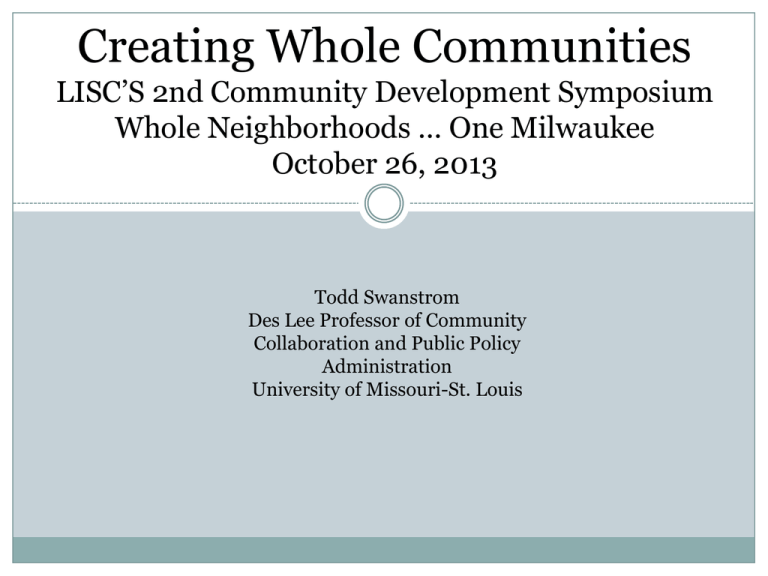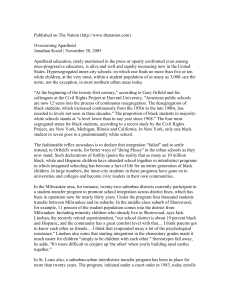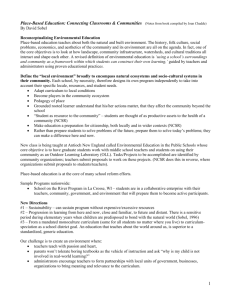Creating Whole Communities by Todd Swanstrom Des Lee
advertisement

Creating Whole Communities LISC’S 2nd Community Development Symposium Whole Neighborhoods … One Milwaukee October 26, 2013 Todd Swanstrom Des Lee Professor of Community Collaboration and Public Policy Administration University of Missouri-St. Louis National Economic Trends: Rising Inequality Rising Inequality Across Space Percentage Change in Median Household Income, 1979-2010 (adjusted for inflation) Rising Poverty Poverty Rate, All of Metro Milwaukee and City of Milwaukee, 1979-2010 Rising Concentrated Poverty Ratio of Growth in Housing Units to Growth in Households, 1990-2000 7. St. Louis 1.70 15. Milwaukee 1.39 Older Neighborhoods Are Running Up the Down Escalator What Can Community Development Do in the Face of National and Regional Trends? 1. Build Mixed-Income Communities Through AssetBased Community Development 2. Connect Low-Income Residents to Regional Opportunity Structures 3. Link Place-Based Initiatives to People-Based Services I. Building Mixed-Income Communities Through Asset-Based Community Development Problems Deficits Assets Opportunities Opportunity: Changing Demographics and Demand for Housing Persons Over Age 65, EWG Region Population Divided by Household, EWG Region Married Couple Households w ith Children, EWG Region 400,000 300,000 3.00 250,000 2.50 200,000 2.00 150,000 1.50 350,000 300,000 250,000 200,000 150,000 More Elderly 100,000 100,000 Fewer "Ozzie & Harriet" Families 50,000 50,000 0 1980 1990 2000 2009 1.00 Smaller households 0.50 0.00 0 1980 1990 2000 2009 1980 1990 2000 2009 Competitive Advantage of Older Urban Neighborhoods Most Walkable Neighborhoods in the City of Milwaukee Walk Northpoin Score t 92 Populatio n 3,571 2 Murray Hill 92 5,593 3 Juneau Town 90 4,533 4 Lower East Side 89 11,412 5 Kilbourn Town 88 3,958 1 Central West End in St. Louis Vacant Housing Units as a Percent of All Units: 1970-2010 25% 20% 15% Central West End St. Louis City 10% 5% Source: US Census Bureau 0% 1970 1980 1990 2000 2010 Change in Median Housing Values: 1970-2010 $300,000 $250,000 $200,000 Central West End St. Louis City $150,000 $100,000 $50,000 Source: US Census Bureau $0 1970 1980 1990 2000 2010 Distribution of Population by Age: Central West End vs St. Louis City 2010 60.00% 50.00% 40.00% Central West End St. Louis City 30.00% 20.00% 10.00% 0.00% Under 18 years 18 to 34 years 35 to 64 years 65 and over Source: US Census Bureau What Explains Success of Central West End? 1. Connectivity 2. Amenities 3. Anchor Institutions But Is the Central West End a Classic Case of Gentrification? Racial/Ethnic Composition 3% 11% 28% 58% White African American Asian Other The Concentrated Poverty “Tax” Effect of Moving From High-Poverty to Low-Poverty Community Loss of wages ................................................ $3,000 Cost of cashing payroll checks ....................... $789 More expensive groceries ................................ $453 More expensive homeowner’s insurance ….... $200 Higher cost of car insurance ............................. $400 TOTAL ............................................................... $4,842 II. Linking Low-Income Communities to Regional Opportunity Structures: The Case of 24:1 Pagedale • Population: 3,304 (- 8.6 % since 2000) • 27 % poverty rate • 40 % female-headed households • 17 % unemployment rate (2012) • Few decent-paying jobs One Major Urban Amenity: MetroLink Station Rock Road Transit-Oriented Development Extensive Citizen Engagement TOD as an Anti-Poverty Strategy Benefits of TOD in Weak-Market Setting III. Link Place-Based Initiatives to People-Based Services Early Childhood Space 56 % of incoming students are not ready for kindergarten (Brigance Test) Over 40 daycare providers No communication between school district and daycare providers Place-Based Collective Impact: Five-by-Five Collective Impact “Backbone Organization:” Beyond Housing Place-based Component: 24:1 Initiative Reinforces Five-by-Five • • • • Bringing daycare facilities up to code Reduction of social isolation through community engagement Free $500 College Savings Account and $4,500 Viking Advantage IDA Housing repairs and reduced mobility Conclusion: What Are the Three Most Important Prerequisites for Creating Whole Communities? Capacity Capacity Capacity!











